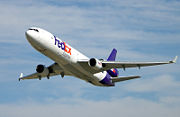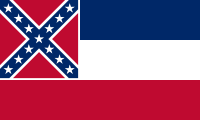Memphis, Tennessee
| City of Memphis | |||
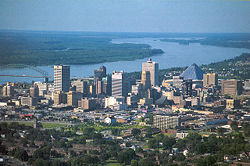 |
|||
|
|||
| Nickname(s): The River City, The Bluff City | |||
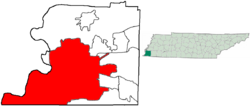 |
|||
| Coordinates: | |||
| Country | United States | ||
|---|---|---|---|
| State | Tennessee | ||
| County | Shelby | ||
| Founded | 1819 | ||
| Incorporated | 1826 | ||
| Government | |||
| - Mayor | W. W. Herenton (D) | ||
| Area | |||
| - City | 313.8 sq mi (763.4 km²) | ||
| - Land | 302.3 sq mi (723.4 km²) | ||
| - Water | 15.4 sq mi (40.0 km²) | ||
| Elevation | 337 ft (103 m) | ||
| Population (2007)[1] | |||
| - City | 674,028(18th) | ||
| - Density | 2,327.4/sq mi (898.6/km²) | ||
| - Metro | 1,260,581 | ||
| - Demonym | Memphian | ||
| Time zone | CST (UTC-6) | ||
| - Summer (DST) | CDT (UTC-5) | ||
| ZIP Codes | 37501, 37544, 38101-38120, 38122, 38124-38128, 38130-38139, 38141-38142, 38145, 38147-38148, 38150-38152, 38157, 38159, 38161, 38163, 38166-38168, 38173-38175, 38177, 38181-38182, 38184, 38186-38188, 38190, 38193-38194, 38197 | ||
| Area code(s) | 901 | ||
| FIPS code | 47-48000[2] | ||
| GNIS feature ID | 1326388[3] | ||
| Website: http://www.memphistn.gov | |||
Memphis is a city in the southwest corner of Tennessee, and the county seat of Shelby County. Memphis rises above the Mississippi River on the 4th Chickasaw Bluff just south of the mouth of the Wolf River.
As of 2007, Memphis had an estimated population of 674,028, making it the largest city in the state of Tennessee, the second largest in the Southeastern United States, and the 18th largest in the United States [1].
The greater Memphis metropolitan area, including adjacent counties in Mississippi and Arkansas, has a population of 1,260,581. This makes Memphis the second largest metropolitan area in Tennessee, surpassed only by metropolitan Nashville, which only overtook Memphis in recent years.
Memphis is the youngest of Tennessee's four major cities (traditionally including Knoxville, Chattanooga, and Nashville). A resident of Memphis is referred to as a Memphian and the Memphis region is known, particularly to media outlets, as the "Mid-South."
Contents |
History
Early history

Because it occupies a substantial bluff rising from the Mississippi river bank, the area is a natural location for settlement. The Memphis area was first settled by the Mississippian Culture and then by the Chickasaw Indian tribe. European exploration came years later, with Spanish explorer Hernando de Soto and French explorers led by René Robert Cavelier, Sieur de La Salle.[4]
The land comprising present-day Memphis remained in a largely unorganized territory throughout most of the 18th century. By 1796, the community was the westernmost point of the newly admitted state of Tennessee.
19th century
Memphis was founded in 1819 by John Overton, James Winchester and Andrew Jackson.[5][6] The city was named after the ancient capital of Egypt on the Nile River. Memphis developed as a transportation center in the 19th century because of its flood-free location, high above the Mississippi River.
As the cotton economy of the antebellum South depended on the forced labor of large numbers of African-American slaves, Memphis became a major slave market. In 1857, the Memphis and Charleston Railroad was completed, the only East-West railroad across the southern states prior to the Civil War.
Tennessee seceded from the Union in June 1861 and Memphis briefly became a Confederate stronghold. Union forces captured Memphis in the Battle of Memphis on June 6, 1862, and the city remained under Union control for the duration of the war. Memphis became a Union supply base and continued to prosper throughout the war.
In the 1870s a series of yellow fever epidemics hit the city. The worst outbreak, in 1878, reduced the population by nearly 75% as many people died or fled the city permanently.
20th century

Memphis grew into the world's largest spot cotton market and the world's largest hardwood lumber market. Into the 1950s, it was the world's largest mule market.[7]
From the 1910s to the 1950s, Memphis was a hotbed of machine politics under the direction of E. H. "Boss" Crump. During the Crump era, Memphis developed an extensive network of parks and public works as part of the national City Beautiful Movement.
During the 1960s the city was at the center of civil rights issues, notably the location of a sanitation workers' strike. Martin Luther King, Jr. was assassinated on April 4, 1968 at the Lorraine Motel.
Memphis is well known for its cultural contributions to the identity of the American south. Many renowned musicians grew up in and around the Memphis and northern Mississippi area.[8] These included such musical greats as Elvis Presley, Muddy Waters,Carl Perkins, Johnny Cash, Robert Johnson, W.C. Handy, B.B. King, Howlin' Wolf, Isaac Hayes, Booker T. Jones, and Al Green.
Geography and climate
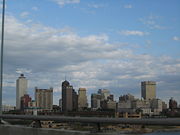
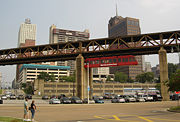
Memphis is located in southwestern Tennessee at .[9] According to the United States Census Bureau, the city has a total area of 313.8 sq mi (763.4 km²), of which 302.3 sq mi (723.4 km²) is land and 15.4 sq mi (40.0 km²), or 5.24%, is water.
Cityscape
The city of Memphis is located in southwestern Tennessee and sits on the eastern bank of the Mississippi River. It is the regional hub for a tri-state area of Arkansas, Mississippi and Tennessee. Interstate 40 (I-40) enters the city from the northeast, and loops above the central part of the city, exiting across the Mississippi River and travelling to the west. Interstate 55 approaches the city from the south and connects with Interstate 240, which completes the loop around central Memphis with I-40, and also leaves to the west.
Aquifer
Shelby County is located over four natural aquifers, one of which is recognized as the "Memphis sand aquifer" or simply as the "Memphis aquifer". This artesian water is pure and soft. This particular water source, located some 350 to 1100 ft (100 - 330 m) underground, is stated to contain more than 100 trillion gallons (380 km³) of water by Memphis Light, Gas, and Water.[10]
Climate
Memphis has a humid subtropical climate, with four distinct seasons. The average high and low in July are 92°F (33°C) and 73°F (23°C), with high levels of humidity due to moisture encroaching from the Gulf of Mexico. Afternoon thunderstorms are frequent during some summers, but usually brief, lasting no longer than an hour. Early Autumn is pleasantly drier and mild, but can remain hot until late October. Winters are mild to chilly, with average January high and low temperatures of 49°F (9°C) and 31°F (-1°C). Late Autumn is rainy and colder; December is the third rainiest month of the year. Snow does occur sporadically in winter, with an average annual accumulation of 5.1 inches (12.9cm).
People and culture
Demographics
| Historical populations | ||
|---|---|---|
| Year | Pop. | %± |
| 1850 | 8,841 | — |
| 1860 | 22,623 | 155.9% |
| 1870 | 40,226 | 77.8% |
| 1880 | 33,592 | −16.5% |
| 1890 | 64,495 | 92.0% |
| 1900 | 102,320 | 58.6% |
| 1910 | 131,105 | 28.1% |
| 1920 | 162,351 | 23.8% |
| 1930 | 253,143 | 55.9% |
| 1940 | 292,942 | 15.7% |
| 1950 | 396,000 | 35.2% |
| 1960 | 497,524 | 25.6% |
| 1970 | 623,530 | 25.3% |
| 1980 | 646,356 | 3.7% |
| 1990 | 610,337 | −5.6% |
| 2000 | 650,100 | 6.5% |
| 2007 (Est.) | 674,028 | 3.7% |
| Source: "American FactFinder". United States Census Bureau. | ||
As of the census[2] of 2000, there were 650,100 people, 250,721 households, and 158,455 families residing in the city. The population density was 2,327.4 people per sq mi (898.6/km²). There were 271,552 housing units at an average density of 972.2 per sq mi (375.4/km²). The racial makeup of the city was 61.41% African American, 34.41% White, 1.46% Asian, 0.19% Native American, 0.04% Pacific Islander, 1.45% from other races, and 1.04% from two or more races. Hispanic or Latino of any race were 2.97% of the population.
The Memphis Metropolitan Statistical Area (MSA), the 42nd largest in the United States, has a 2003 population of 1,239,337, and includes the Tennessee counties of Shelby, Tipton, and Fayette, as well as the Mississippi counties of DeSoto, Marshall, Tate, and Tunica, and the Arkansas county of Crittenden.
Crime
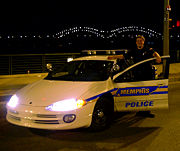
Although in 2004 violent crime in Memphis reached a record low for over a decade, that trend has changed. In 2005, Memphis was ranked the 4th most dangerous city with a population of 500,000 or higher in the U.S.[11] Crime in Memphis increased in 2005, and has seen a dramatic rise in the first half of 2006. Nationally, cities follow similar trends, and crime numbers tend to be cyclical. Local experts and criminologists cite gang recruitment as one possible cause of the rise in crime in Memphis and to a reduction of 66% of federal funding to the Memphis Police Department.
In the first half of 2006, robbery of businesses increased 52.5%, robbery of individuals increased 28.5%, and homicide increased 18% over the same period of 2005. The Memphis Police Department has responded with the initiation of Operation Blue C.R.U.S.H. (Crime Reduction Using Statistical History), which targets crime hotspots and repeat offenders.[12] Memphis ended 2005 with 154 murders, and 2006 ended with 160 murders. In 2006, the Memphis metropolitan area ranked second most dangerous in the nation, it also ranked first most dangerous in 2002 and second most dangerous the year before in 2001. Recently, Memphis ranked second most dangerous among cities over 500,000 in 2007, as well as the second most dangerous metropolitan area once again.[13] In 2006, the Memphis metropolitan area ranked number one in violent crimes for major cities around the U.S according to the FBI's annual crime rankings, where it had ranked 2nd in 2005.[14]
Cultural events

One of the largest celebrations in Memphis is Memphis in May. The month-long series of events promotes Memphis' heritage and outreach of its people far beyond the city's borders. There are four main events, the Beale Street Music Festival, International Week, the World Championship Barbecue Cooking Contest, and the Sunset Symphony. The World Championship Barbecue Cooking Contest is the largest pork barbecue cooking contest in the world.
Carnival Memphis, formerly known as the Memphis Cotton Carnival, is an annual series of parties and festivities in the month of June that salutes various aspects of Memphis and its industries. An annual King and Queen of Carnival are secretly selected to reign over Carnival activities. The African-American community staged a parallel event known as the Cotton Makers Jubilee from 1935 to 1982, when it merged with Carnival Memphis.[15]
An arts festival, the Cooper-Young Festival, is held annually in September in the Cooper-Young district of Midtown Memphis. The event draws artists from all over North America, and includes art sales, contests, and displays.
The arts
Memphis is the home of founders and establishers of various American music genres, including Blues, Gospel, Rock n' Roll, Buck, Crunk, and "sharecropper" country music (in contrast to the "rhinestone" country sound of Nashville). Johnny Cash, Elvis Presley, and B. B. King were all getting their starts in Memphis in the 1950s. They are respectively dubbed the "King" of Country, Rock n' Roll, and Blues.
Well-known writers from Memphis include Civil War historian Shelby Foote and playwright Tennessee Williams. Novelist John Grisham grew up in nearby DeSoto County, Mississippi and many of his books are set in Memphis.
Cultural references to Memphis
Memphis is the subject of many major pop and country songs, including "Memphis" by Chuck Berry, "Queen of Memphis" by Confederate Railroad, "Memphis Soul Stew" by King Curtis, "Maybe It Was Memphis" by Pam Tillis, "Graceland" by Paul Simon, "Memphis Train" by Rufus Thomas, and "Walking in Memphis" by Marc Cohn.
In addition, Memphis is mentioned in scores of other songs, including "Proud Mary" by Creedence Clearwater Revival, "Honky Tonk Women" by the Rolling Stones, "Life Is a Highway" by Tom Cochrane, "Black Velvet" by Alannah Myles, and many others.
Religion
Since its founding, Memphis has been home to persons of many different faiths. An 1870 map of Memphis shows religious buildings of the Baptist, Catholic, Episcopal, Methodist, Presbyterian, Congregational, and Christian denominations and a Jewish congregation.[16]
In 2008, places of worship exist for Christians, Jews, Muslims, Buddhists, and Hindus.
Bellevue Baptist Church is a Southern Baptist megachurch in Memphis that was founded in the early 20th century. Its current membership is approximately 27,000. For many years, it was led by Adrian Rogers, a former three term president of the Southern Baptist Convention.
The international headquarters of the Church of God in Christ is located in Memphis. Named after the denomination's founder, Charles Harrison Mason, Mason Temple is where Martin Luther King Jr. gave his famous "I've Been to the Mountaintop" speech the day before he was killed.
Other notable and/or large churches in Memphis include Second Presbyterian Church (EPC), Christ United Methodist Church, Idlewild Presbyterian Church (PCUSA), and Calvary Episcopal Church.
Memphis is the seat of a Roman Catholic Diocese, most of whose communicants reside in Memphis and surrounding suburbs.
Memphis is home to an estimated 10,000 to 15,000 Muslims of various cultures and ethnicities.[17]
Memphis is home to Temple Israel, a Reform synagogue that has approximately 7,000 members, making it one of the largest Reform synagogues in the country. Baron Hirsch Orthodox Synagogue is the largest Orthodox shul in America.
Economy
The city's central location has led to much of its business development. Located on the Mississippi River and intersected by several freight railroads and two Interstate highways, Memphis is ideally located for commerce among the transportation and shipping industry. River barges are unloaded onto trucks and trains. The city is home to the world's busiest cargo airport, which serves as the primary hub for FedEx shipping.
Memphis is home to a number of nationally and internationally-known corporations, including approximately 150 businesses from 22 countries. These include the corporate headquarters of FedEx Corporation, AutoZone Incorporated, International Paper, and Morgan Keegan & Company, Inc.. In addition, Memphis is home to pharmaceutical/healthcare giant Schering-Plough Corporation. Located on Jackson Avenue, Schering-Plough Healthcare Products serves as both the company's primary distribution facilty and research & development center.
The entertainment and film industry have discovered Memphis in recent years. Several major motion pictures have been filmed in Memphis, including The Firm (1993), Cast Away (2000), Hustle and Flow (2006) and Walk the Line (2005).
The city appeared in the top eight of the 50 best major metro areas in the U.S. for starting and growing a business in 2000, according to Inc. magazine.
Government
Memphis is governed by a mayor and thirteen City Council members, six elected at large from throughout the city and seven elected from geographic districts. In 1995, the council adopted a new district plan which changed council positions to all districts. This plan provides for nine districts, seven with one representative each and two districts with three representatives each. The current mayor of the city of Memphis is Dr. W. W. Herenton
In recent years, there have been often rancorous discussions of the potential of a consolidation of unincorporated Shelby County and Memphis into a metropolitan government, similar to that in Nashville.
Education
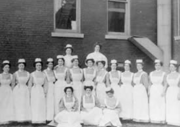
The city is served by Memphis City Schools while surrounding suburbs in other areas of Shelby County are served by Shelby County Schools.
Memphis is home to many private, college-prep schools: Memphis University School (boys), Hutchison School (girls), St. Mary's Episcopal School (girls), St. George's Independent School (co-ed), and Evangelical Christian School (co-ed).
Colleges and universities located in the city include the University of Memphis (formerly Memphis State University), Rhodes College (formerly Southwestern at Memphis), Memphis College of Art, Le Moyne-Owen College, Crichton College, Christian Brothers University and the University of Tennessee Health Science Center (Colleges of Dentistry, Medicine, Nursing, Pharmacy, Graduate Health Sciences and Allied Health Sciences).
The University of Tennessee College of Dentistry was founded in 1878 making it the oldest dental college in the South, and the third oldest public college of dentistry in the United States.[18]
Transportation
Highways
Interstate 40 (I-40) and Interstate 55 (I-55) are the main freeways in the Memphis area. The interstates I-40 and I-55 (along with rail lines) cross the Mississippi at Memphis into the state of Arkansas.
Railroad

A large volume of railroad freight traffic moves through Memphis, thanks to two Mississippi River railroad crossings and the convergence of several east-west and north-south rail lines.
By the early 20th Century, Memphis had two major rail passenger stations. After rail passenger service declined at mid-century, Memphis Union Station was razed in 1969. Memphis Central Station[19] was renovated and now serves Amtrak's famed City of New Orleans, providing service between Chicago and New Orleans.
Airport
Memphis is served by Memphis International Airport, which handles more cargo than any other airport in the world as of 2007.
River port
Memphis also has the 2nd biggest cargo port on the Mississippi River (the 4th biggest inland port in the United States).[20] The International Port of Memphis covers the Tennessee and Arkansas sides of the Mississippi River from river mile 725 (km 1167) to mile 740 (km 1191).[21]
Bridges
Four rail and highway bridges cross the Mississippi River at Memphis. They are, in order of their opening year: Frisco Bridge (1892), Harahan Bridge (1916), Memphis-Arkansas Memorial Bridge (1949) and the Hernando de Soto Bridge (1973).
Tourism and recreation
Museums and art collections
Many museums of interest are located in Memphis.


National Civil Rights Museum
The National Civil Rights Museum is located in the former Lorraine Motel where Martin Luther King, Jr. was assassinated. It includes a historical overview of the American civil rights movement.
Brooks Museum of Art
The Memphis Brooks Museum of Art, founded in 1916, is the oldest and largest fine art museum in the state of Tennessee.[22] The Brooks' permanent collection includes works from the Italian Renaissance and Baroque eras to British, French Impressionists, and 20th-century artists.
Graceland
Graceland, the former home of Rock 'n' Roll legend Elvis Presley, is one of the most visited houses in the United States (second only to the White House), attracting over 600,000 domestic and international visitors a year. Featured at Graceland are two of Presley's private airplanes, his extensive automobile and motorcycle collection and other Elvis memorabilia. On November 7, 1991 Graceland was listed in the National Register of Historic Places.[23]
Pink Palace
The Pink Palace Museum, serves as the Mid-South's major science and historical museum, and features exhibits ranging from archeology to chemistry. It includes America's third largest planetarium and an IMAX Theatre. One exhibit features a replica of the original Piggly Wiggly store, the first self-service grocery store, commemorating the invention of the supermarket by Memphian Clarence Saunders in 1916.
Memphis Walk of Fame
The Memphis Walk of Fame is a public exhibit located in the Beale Street historic district, which is modelled after the Hollywood Walk of Fame, but is designated exclusively for Memphis musicians, singers, writers, and composers. Honorees include W. C. Handy, B. B. King, Bobby Blue Bland, and Alberta Hunter among others.
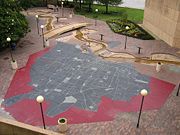
Mud Island River Park
Mud Island River Park and Mississippi River Museum is located on Mud Island in downtown Memphis. The Park is noted for its River Walk. The River walk is a 2112:1 scale working model showing 1000 mi (1600 km) of the Lower Mississippi River, from Cairo, Illinois to New Orleans, Louisiana and the Gulf of Mexico. 30 in (75 cm) in the model equal 1 mi (1.6 km) of the Mississippi River. The Walk stretches roughly 0.5 mi (800 m), allowing visitors to walk in the water and see models of cities and bridges along the way.
Victorian Village
Victorian Village is a historic district of Memphis featuring a series of fine Victorian-era mansions, some of which are open to the public as museums.
Cotton Museum
The Cotton Museum is a museum that opened in March 2006 on the old trading floor of the Memphis Cotton Exchange at 65 Union Avenue in downtown Memphis.
Parks
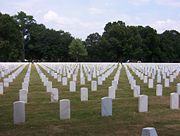
Major Memphis parks include W.C. Handy Park, Tom Lee Park, Audubon Park, Overton Park including the Old Forest Arboretum of Overton Park, the Lichterman Nature Center - a nature learning center, and the Memphis Botanic Garden.
Shelby Farms park, located at the eastern edge of the city, is one of the largest urban parks in America.
Cemeteries
The Memphis National Cemetery is a United States National Cemetery located in north Memphis.
Historic Elmwood Cemetery is one of the first rural garden cemeteries in the South, and contains the Carlisle S. Page Arboretum.
Other points of interest
Beale Street
Blues fans can visit Beale Street, where a young B.B. King used to play his guitar. He occasionally still appears there at the club bearing his name, which he partially owns. Street performers play live music, and bars and clubs feature live entertainment around the clock. In 2008, Beale Street is the most visited tourist attraction in the state of Tennessee.
Sun Studio
Sun Studio was where Elvis Presley first recorded "My Happiness" and "That's When Your Heartaches Begin". Other famous musicians who got their start at Sun include Johnny Cash, Rufus Thomas, Charlie Rich, Howlin' Wolf, Roy Orbison, Carl Perkins, and Jerry Lee Lewis.
Memphis Zoo
The Memphis Zoo, which is located in midtown Memphis, features many exhibits of mammals, birds, fish, and amphibians from all over the world.
Other
Other Memphis attractions include the Liberty Bowl Memorial Stadium, the FedExForum and Mississippi riverboat cruises.
Sports
Memphis is home to several professional sports teams, but college basketball team University of Memphis Tigers is the most successful and popular.
- Memphis Grizzlies of the National Basketball Association, the only one of the "big four" major sports leagues in the city
- Memphis Redbirds of the Pacific Coast League, a Triple A baseball farm team for the St. Louis Cardinals
- Mississippi RiverKings, a professional hockey team of the Central Hockey League
Memphis is home to Liberty Bowl Memorial Stadium which is the site of University of Memphis football, AutoZone Liberty Bowl and Southern Heritage Classic.
Memphis is home to the annual Stanford St. Jude Championship, a regular part of the PGA Tour.
Memphis has a significant history in pro wrestling. Jerry "The King" Lawler is the sport's greatest name to come out of the city. Sputnik Monroe, a wrestler of the 1950s, promoted racial integration.
Memphis is home to Memphis Motorsports Park, just north of the city near Millington, Tennessee.
See also
- List of famous people from Memphis
- List of mayors of Memphis
- Memphis Mafia
References
- ↑ 1.0 1.1 "Table 1: Annual Estimates of the Population for Incorporated Places Over 100,000, Ranked by July 1, 2007 Population: April 1, 2000 to July 1, 2007" (CSV). 2007 Population Estimates. United States Census Bureau, Population Division (2008-07-14). Retrieved on 2008-07-14.
- ↑ 2.0 2.1 "American FactFinder". United States Census Bureau. Retrieved on 2008-01-31.
- ↑ "US Board on Geographic Names". United States Geological Survey (2007-10-25). Retrieved on 2008-01-31.
- ↑ Tennessee Encyclopedia of History and Culture - Fort Prudhomme and La Salle
- ↑ "TN Encyclopedia: John Overton". The Tennessee Encyclopedia of History and Culture. Retrieved on 2008-10-24.
- ↑ "Memphis History and Facts". Memphis Public Library. Retrieved on 2008-10-24.
- ↑ City of Memphis Website - History of Memphis
- ↑ Peter Guralnick. New York Times, August 11, 2007
- ↑ "US Gazetteer files: 2000 and 1990". United States Census Bureau (2005-05-03). Retrieved on 2008-01-31.
- ↑ Memphis Light, Gas, and Water Website - About Our Services
- ↑ Morgan Quitno 2006 Crime Rankings
- ↑ Ashby, Andrew (2006-04-07). "Operation Blue C.R.U.S.H. Advances at MPD". Memphis Daily News 121 (76). http://www.memphisdailynews.com/Editorial/StoryLead.aspx?id=92313. Retrieved on 2007-08-02.
- ↑ Morgan Quitno 2007 Crime Rankings
- ↑ Conley, Christopher (2007-09-27). "Memphis leads U.S. in violent crime". Commercial Appeal. http://www.commercialappeal.com/news/2007/sep/27/memphis-leads-us-in-violent-crime/. Retrieved on 2007-10-31.
- ↑ Cotton Carnival
- ↑ Bird's eye view of the city of Memphis, Tennessee 1870.
- ↑ Muslims in Memphis: Diversity in the mosque
- ↑ University of Tennessee-Memphis Dentistry Website
- ↑ Memphis Central Station Pictures
- ↑ Top US Inland Ports for 2003
- ↑ Port of Memphis website - About Page
- ↑ http://www.brooksmuseum.org Memphis Brooks Museum of Art
- ↑ "National Register Information System". National Register of Historic Places. National Park Service (2007-01-23).
External links
- Official City Government Website
- Memphis Convention & Visitors Bureau
- Memphis Chamber of Commerce
- Memphis History
- Memphis Daily Newspaper - The Commercial Appeal
- Bird's eye view of the city of Memphis, Tennessee 1870. (Library of Congress)
- Perspective map of the city of Memphis, Tenn. 1887. (Library of Congress)
- Memphis, Tennessee travel guide from Wikitravel
 |
Millington | Bartlett, Lakeland |
|
||||
| West Memphis AR, Marion AR | Cordova (Memphis) | ||||||
| Walls MS | Whitehaven (Memphis), Southaven MS | Germantown, Olive Branch MS, Collierville |
|
|||||||||||||||||
|
||||||||||||||||||||||
|
|||||
|
|
|||||||||||
|
|||||||||||||

